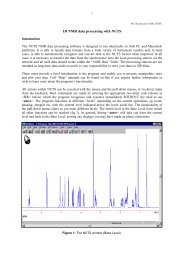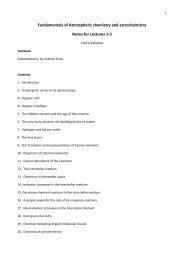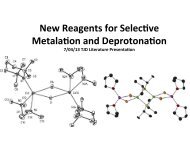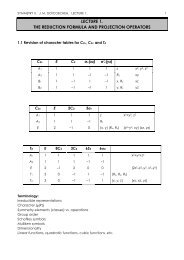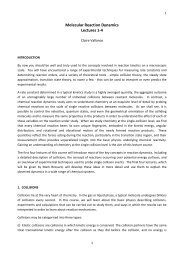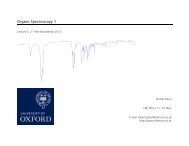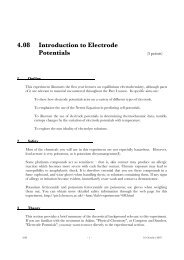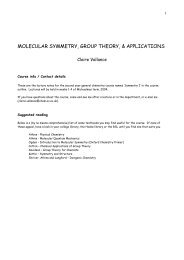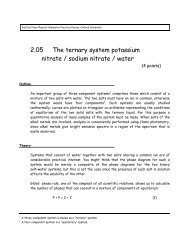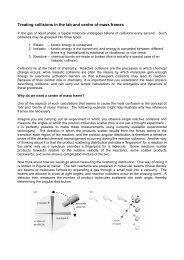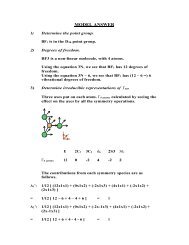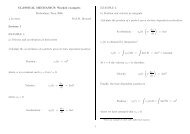Diamond deposition in a DC-arc Jet CVD system: investigations of ...
Diamond deposition in a DC-arc Jet CVD system: investigations of ...
Diamond deposition in a DC-arc Jet CVD system: investigations of ...
Create successful ePaper yourself
Turn your PDF publications into a flip-book with our unique Google optimized e-Paper software.
Ž .<br />
<strong>Diamond</strong> and Related Materials 10 2001 370375<br />
<strong>Diamond</strong> <strong>deposition</strong> <strong>in</strong> a <strong>DC</strong>-<strong>arc</strong> <strong>Jet</strong> <strong>CVD</strong> <strong>system</strong>:<br />
<strong>in</strong>vestigations <strong>of</strong> the effects <strong>of</strong> nitrogen addition<br />
J.A. Smith, K.N. Rosser, H. Yagi 1 , M.I. Wallace 2 , P.W. May, M.N.R. Ashfold <br />
School <strong>of</strong> Chemistry, Uniersity <strong>of</strong> Bristol, Bristol BS8 1TS, UK<br />
Abstract<br />
Studies <strong>of</strong> the chemical vapour <strong>deposition</strong> <strong>of</strong> diamond films at growth rates 100 m h 1 with a 10-kW <strong>DC</strong>-<strong>arc</strong> jet <strong>system</strong> are<br />
described. Additions <strong>of</strong> small amounts <strong>of</strong> N to the standard CH H Ar feedstock gas results <strong>in</strong> strong CNŽ BX.<br />
2 4 2<br />
emission,<br />
and quenches C Ž da.<br />
2 and H emissions from the plasma. Species selective, spatially resolved optical emission measurements<br />
have enabled derivation <strong>of</strong> the longitud<strong>in</strong>al and lateral variation <strong>of</strong> emitt<strong>in</strong>g C , CN radicals and H Ž n3.<br />
2<br />
atoms with<strong>in</strong> the<br />
plasma jet. Scann<strong>in</strong>g electron microscopy and laser Raman analyses <strong>in</strong>dicate that N2<br />
additions also degrade both the growth rate<br />
and quality <strong>of</strong> the deposited diamond film; the latter technique also provides some evidence for nitrogen <strong>in</strong>clusion with<strong>in</strong> the<br />
films. 2001 Elsevier Science B.V. All rights reserved.<br />
Keywords: <strong>Diamond</strong> growth; <strong>DC</strong> <strong>arc</strong> plasma jet; Chemical vapour <strong>deposition</strong>; Optical emission; Nitrogen additions<br />
1. Introduction<br />
<strong>DC</strong>-<strong>arc</strong> jet plasmas operat<strong>in</strong>g with hydrocarbon<br />
H 2Ar gas mixtures enable chemical vapour <strong>deposition</strong><br />
Ž <strong>CVD</strong>.<br />
<strong>of</strong> high quality diamond films at growth rates<br />
unobta<strong>in</strong>able us<strong>in</strong>g the more traditional hot filament or<br />
microwave reactors 1 . The <strong>DC</strong>-<strong>arc</strong> jet, therefore, provides<br />
an excellent environment <strong>in</strong> which to study the<br />
mechanism <strong>of</strong> diamond <strong>CVD</strong>. Due to the low residence<br />
time, the chemical mechanism is much simplified <strong>in</strong><br />
comparison with hot filament or microwave <strong>system</strong>s<br />
allow<strong>in</strong>g modell<strong>in</strong>g <strong>of</strong> the plasma plume, given accurate<br />
measurements <strong>of</strong> the boundary conditions 2,3 . The<br />
high temperatures and the large reactive radical flux<br />
<br />
Correspond<strong>in</strong>g author. Tel.: 44-117-928-83123; fax: 44-117-<br />
925-0612.<br />
E-mail address: mike.ashfold@bris.ac.uk Ž M.N.R. Ashfold ..<br />
1 Permanent address: Department <strong>of</strong> Mechanical Eng<strong>in</strong>eer<strong>in</strong>g,<br />
Ehime University, Matsuyama 79077, Japan.<br />
2 Present address: Department <strong>of</strong> Chemistry, University <strong>of</strong> Cambridge,<br />
Lensfield Road, Cambridge CB2 1EW, UK.<br />
complicate diagnostic measurements, but spatially<br />
resolved optical emission and laser-<strong>in</strong>duced fluorescence<br />
Ž LIF.<br />
measurements have been reported for several<br />
species <strong>in</strong> <strong>DC</strong>-<strong>arc</strong> plasma jet reactors 4 .<br />
The present contribution describes studies <strong>of</strong> nitrogen<br />
addition to a tw<strong>in</strong>-torch <strong>DC</strong>-<strong>arc</strong> plasma jet operat<strong>in</strong>g<br />
with a CH 4H 2Ar gas mixture, both <strong>in</strong> terms <strong>of</strong><br />
the characteristics <strong>of</strong> the films produced and its <strong>in</strong>fluence<br />
on the gas phase chemistry. Related studies <strong>of</strong> the<br />
effects <strong>of</strong> N2<br />
additions have been reported <strong>in</strong> the case<br />
<strong>of</strong> diamond <strong>CVD</strong> us<strong>in</strong>g hot filament 5,6 , microwave<br />
79 and oxy-acetylene torch 10<br />
reactors. All show a<br />
peak <strong>in</strong> growth rate and film quality with the <strong>in</strong>troduction<br />
<strong>of</strong> appropriate trace amounts <strong>of</strong> N 2; controlled<br />
addition <strong>of</strong> N2<br />
has also been shown to <strong>in</strong>duce selective<br />
facet formation <strong>in</strong> these diamond <strong>CVD</strong> <strong>system</strong>s.<br />
Films grown <strong>in</strong> the present study have been analysed<br />
by scann<strong>in</strong>g electron microscopy Ž SEM.<br />
and laser Raman<br />
spectroscopy Ž LRS .. The <strong>DC</strong>-<strong>arc</strong> plasma jet thus<br />
far has been monitored by spatially resolved optical<br />
emission spectroscopy Ž OES.<br />
only, with particular reference<br />
to emissions from electronically excited H atoms,<br />
0925-963501$ - see front matter 2001 Elsevier Science B.V. All rights reserved.<br />
Ž .<br />
PII: S 0 9 2 5 - 9 6 3 5 0 0 00444-1
and C 2 and CN radicals both along the length <strong>of</strong>, and<br />
transverse to, the <strong>arc</strong> jet axis. Abel <strong>in</strong>version methods<br />
11<br />
have been used to transform measured species<br />
selected, spatially resolved, OES <strong>in</strong>tensities <strong>in</strong>to radial<br />
distributions <strong>of</strong> the chosen emitt<strong>in</strong>g species. OES, <strong>of</strong><br />
course, only gives access to excited state species which,<br />
given their low relative abundance, are generally considered<br />
not to be important <strong>in</strong> the overall diamond<br />
growth process. More detailed <strong>in</strong>terpretation <strong>of</strong> such<br />
measurements and, particularly, their relation to the<br />
more abundant ground state species requires rather<br />
detailed knowledge <strong>of</strong> both the production and quench<strong>in</strong>g<br />
mechanisms for these excited species, but the spatial<br />
variations and trends with changes <strong>in</strong> process condition<br />
can serve as a useful plasma diagnostic.<br />
( )<br />
J.A. Smith et al. <strong>Diamond</strong> and Related Materials 10 2001 370375 371<br />
2. Experimental<br />
2.1. Film <strong>deposition</strong> and characterization<br />
Fig. 1 provides a schematic illustration <strong>of</strong> the experimental<br />
apparatus used for film <strong>deposition</strong> and for<br />
observ<strong>in</strong>g optical emission from the plasma. The <strong>DC</strong>-<strong>arc</strong><br />
jet plasma is generated us<strong>in</strong>g a tw<strong>in</strong> torch head arrangement<br />
Ž Aeroplasma Corp. . designed to operate at<br />
up to 10 kW discharge power. Tw<strong>in</strong> torch arrangements<br />
such as this provide improved plasma stability over<br />
s<strong>in</strong>gle torch <strong>system</strong>s. The N-torch is designed to propagate<br />
a stable plasma flow by <strong>in</strong>corporat<strong>in</strong>g a secondary<br />
spiral jet stream <strong>of</strong> pre-mixed Ar and H 2 <strong>in</strong>to the<br />
primary Ar plasma prior to the converg<strong>in</strong>g-diverg<strong>in</strong>g<br />
nozzle orifice. Methane and, when required, N2<br />
are<br />
<strong>in</strong>troduced <strong>in</strong>to the ArH 2 plasma through an annular<br />
<strong>in</strong>jection r<strong>in</strong>g Ž I <strong>in</strong> Fig. 1.<br />
positioned 100 mm downstream<br />
from the nozzle. All gas flows are metered us<strong>in</strong>g<br />
appropriate mass flow controllers Ž MKS .. The plasma<br />
imp<strong>in</strong>ges normal to the surface <strong>of</strong> a water-cooled<br />
polished Ž us<strong>in</strong>g 1 m grade diamond dust.<br />
molybdenum<br />
substrate Ž 16 mm diameter ., positioned 155 mm<br />
from the nozzle exit, on which the polycrystall<strong>in</strong>e diamond<br />
film condenses. The pressure <strong>in</strong> the reaction<br />
chamber is monitored cont<strong>in</strong>ually and controlled at 50<br />
torr. The chamber is water-cooled and evacuated to a<br />
base pressure <strong>of</strong> 50 mtorr us<strong>in</strong>g a two stage rotary<br />
pump Ž Edwards E2M40 .. All films produced for this<br />
study were grown at a substrate temperature <strong>of</strong> 880C,<br />
measured by a two-colour optical pyrometer. Each <strong>deposition</strong><br />
lasted one hour, with identical CH 4H 2Ar<br />
flow rates, variable N additions, and a constant <strong>in</strong>put<br />
2<br />
power <strong>of</strong> 5.9 kW Ž 78 V, 76 A .. The result<strong>in</strong>g films<br />
delam<strong>in</strong>ate on cool<strong>in</strong>g and are analysed as free-stand<strong>in</strong>g.<br />
Growth rate and surface topology are revealed by<br />
SEM, while laser Raman spectroscopy ŽRenishaw, He-<br />
Cd laser excitation at 325 nm.<br />
provides an <strong>in</strong>dication <strong>of</strong><br />
film quality.<br />
Fig. 1. Section Ž schematic.<br />
through the apparatus for film <strong>deposition</strong><br />
and OES measurements. The plasma jet propagates <strong>in</strong> the z<br />
direction, with the surface <strong>of</strong> the substrate Ž S.<br />
positioned at z0.<br />
Optical emission Ž <strong>in</strong> the y direction.<br />
is viewed through a quartz<br />
w<strong>in</strong>dow Ž Q ., a tra<strong>in</strong> <strong>of</strong> iris diaphragms and a fibre optic bundle Ž O .,<br />
dispersed with the monochromator Ž M.<br />
and detected with a CCD<br />
array. The x-axis is orthogonal to the plane <strong>of</strong> the figure. Key to<br />
other components: I, <strong>in</strong>jection r<strong>in</strong>g for CH Ž and N .<br />
4 2 ; V, connections<br />
to rotary pump; W, cool<strong>in</strong>g water Ž <strong>in</strong> and out ..<br />
2.2. Optical emission spectroscopy<br />
Spatially resolved distributions <strong>of</strong> optical emission<br />
from electronically excited H atoms, and C 2 and CN<br />
radicals have been measured. A 2 mm-diameter column<br />
<strong>of</strong> the plume emission was def<strong>in</strong>ed by a comb<strong>in</strong>ation <strong>of</strong><br />
two irises positioned, <strong>in</strong> series, <strong>in</strong> front <strong>of</strong> a quartz fibre<br />
optic bundle all <strong>of</strong> which were mounted on a common<br />
two-dimensional translation stage. Optical emission was<br />
collected at 1-mm <strong>in</strong>tervals along the z-axis <strong>in</strong> the<br />
region 0z26 mm def<strong>in</strong>ed <strong>in</strong> Fig. 1, and at 2-mm<br />
<strong>in</strong>tervals <strong>in</strong> the range 4x16 mm Ži.e. out <strong>of</strong><br />
plane depicted <strong>in</strong> Fig. 1.<br />
for several different fixed z<br />
values, each separated by 5 mm, <strong>in</strong> front <strong>of</strong> the substrate<br />
surface and perpendicular to the plasma flow.<br />
Spectra were collected us<strong>in</strong>g a UV extended CCD<br />
array detector mounted onto either a 12.5-cm<br />
Ž<br />
1<br />
monochromator Oriel Instaspec IV, 600 l<strong>in</strong>es mm<br />
ruled grat<strong>in</strong>g. or a 0.5-m monochromator ŽSpex 1870,<br />
1<br />
equipped with a 2400-l<strong>in</strong>es mm holographic grat<strong>in</strong>g.<br />
depend<strong>in</strong>g on the wavelength range and resolution<br />
required. The CCD array detector allows simultaneous<br />
collection <strong>of</strong> all emission with<strong>in</strong> a chosen wavelength<br />
range.<br />
3. Results and discussion<br />
<strong>Diamond</strong> films deposited and OES measurements<br />
taken <strong>in</strong> this study all used a fixed ArH CH feed<br />
2 4
372<br />
( )<br />
J.A. Smith et al. <strong>Diamond</strong> and Related Materials 10 2001 370375<br />
gas ratio and flow rate ŽAr 87.83%, H 2 11.59%, CH 4<br />
0.58%, total flow rate 13.8 slm.<br />
with the addition <strong>of</strong><br />
various known quantities <strong>of</strong> N2<br />
<strong>in</strong> the range 020 sccm<br />
Ž for film growth.<br />
and 0100 sccm for OES studies.<br />
3.1. Film <strong>deposition</strong><br />
A series <strong>of</strong> films were deposited with different N 2<br />
flow rates each for 1-h growth duration. Cross-sectional<br />
SEM images allow <strong>in</strong>vestigation <strong>of</strong> the film morphology<br />
and estimation <strong>of</strong> the <strong>deposition</strong> rate, measured at the<br />
film centre, as a function <strong>of</strong> added N 2. Representative<br />
SEM images <strong>of</strong> films grown with N2<br />
additions <strong>of</strong>,<br />
respectively, 0 and 1 sccm are shown as <strong>in</strong>sets <strong>in</strong> Fig.<br />
2a. These illustrate that N2<br />
addition to the process gas<br />
mixture affects the film morphology. <strong>Diamond</strong> films<br />
grown with no added N are predom<strong>in</strong>antly Ž 111.<br />
2<br />
faceted, and exhibit tw<strong>in</strong>n<strong>in</strong>g and secondary nucleation<br />
while, with addition <strong>of</strong> 1 sccm N 2, a central region <strong>of</strong><br />
largely Ž 100.<br />
growth is formed, <strong>in</strong> which some <strong>of</strong> the<br />
crystallites exhibit facets approach<strong>in</strong>g 60 m <strong>in</strong> size.<br />
Further addition <strong>of</strong> N2<br />
promotes the growth <strong>of</strong> ballastype<br />
features. Fig. 2a shows the measured growth rate<br />
Ž<br />
1<br />
m h . <strong>in</strong>creas<strong>in</strong>g with trace N2<br />
additions but then<br />
decreas<strong>in</strong>g with <strong>in</strong>creas<strong>in</strong>g N 2; s<strong>in</strong>ce the films grown at<br />
higher N2<br />
partial pressures are <strong>in</strong>creas<strong>in</strong>gly graphitic,<br />
and thus have lower density, the growth rate def<strong>in</strong>ed as<br />
deposited mass per hour would fall <strong>of</strong>f even more<br />
steeply with <strong>in</strong>creas<strong>in</strong>g N 2.<br />
Laser Raman spectroscopy is also used to assess the<br />
quality <strong>of</strong> the as-grown films. Representative spectra <strong>of</strong><br />
films grown with addition <strong>of</strong>, respectively, 0 and 10<br />
sccm <strong>of</strong> N2<br />
to the process gas mixture are shown as<br />
<strong>in</strong>sets <strong>in</strong> Fig. 2b, while the ma<strong>in</strong> body <strong>of</strong> this figure<br />
illustrates the reduction <strong>in</strong> film quality that accompanies<br />
<strong>in</strong>creased N2<br />
flow rates. Quality here is represented<br />
by the quotient, Q D, where<br />
Ž . Ž .<br />
Q I I I 1<br />
D D D G<br />
and ID<br />
and IG<br />
are, respectively, the relative <strong>in</strong>tensities<br />
3<br />
Ž<br />
1<br />
<strong>of</strong> the sp C peak at a Stokes shift <strong>of</strong> 1332 cm .<br />
2<br />
Ž<br />
1<br />
and the sp C feature centred at 1550 cm ..<br />
Careful studies <strong>in</strong> other <strong>CVD</strong> environments have generally<br />
shown an improvement <strong>in</strong> diamond film quality<br />
upon small N2<br />
additions, followed by a decl<strong>in</strong>e at<br />
higher levels <strong>of</strong> added nitrogen, but we see only a<br />
reduction <strong>in</strong> QD with <strong>in</strong>creas<strong>in</strong>g N2<br />
additions h<strong>in</strong>t<strong>in</strong>g<br />
at an obstructive role for nitrogen <strong>in</strong> the diamond<br />
step growth mechanism. This may reflect the poorer<br />
base vacuum <strong>of</strong> the large <strong>DC</strong>-<strong>arc</strong> plasma jet reactor,<br />
such that it is always operat<strong>in</strong>g at a background partial<br />
pressure <strong>of</strong> air and thus nitrogen above those for<br />
optimal diamond film quality. Consistent with this, we<br />
observe a weak Raman feature at 2328 cm 1 which,<br />
it has been suggested 12 , should be associated with a<br />
Fig. 2. Plots show<strong>in</strong>g the <strong>in</strong>fluence <strong>of</strong> added N on Ž.<br />
2 a film growth<br />
rate and Ž b. film quality, Ž Q .<br />
D . SEM images <strong>of</strong> the central portions <strong>of</strong><br />
films deposited with: Ž. i 0; and Ž ii.<br />
1 sccm added N2<br />
are shown as<br />
<strong>in</strong>sets <strong>in</strong> Ž. a . The <strong>in</strong>set <strong>in</strong> Ž. b displays laser Raman spectra <strong>of</strong> films<br />
grown with 0 and 10 sccm Ž upper and lower traces, respectively.<br />
<strong>of</strong> N 2<br />
added to the standard CH 4H 2Ar process gas mixture, scaled and<br />
<strong>of</strong>fset vertically for clarity <strong>of</strong> presentation.<br />
carbon-nitrogen stretch<strong>in</strong>g mode. This feature is present<br />
<strong>in</strong> all Raman spectra measured <strong>in</strong> this study,<br />
<strong>in</strong>clud<strong>in</strong>g those <strong>of</strong> films grown <strong>in</strong> a standard<br />
CH H Ar gas mixture with no <strong>in</strong>tentionally added<br />
4 2<br />
N . Unfortunately, it is not sufficiently <strong>in</strong>tense for<br />
2<br />
reliable <strong>in</strong>ter-film comparisons. Photolum<strong>in</strong>escence<br />
studies follow<strong>in</strong>g excitation at longer wavelengths will<br />
be useful <strong>in</strong> assess<strong>in</strong>g the extent <strong>of</strong> N <strong>in</strong>corporation <strong>in</strong><br />
these films grown by <strong>DC</strong>-<strong>arc</strong> plasma jet <strong>CVD</strong>.<br />
3.2. OES studies<br />
The emission spectra <strong>of</strong> CH 4H 2ArN2<br />
plasmas<br />
are dom<strong>in</strong>ated by the C Žd 3 a 3 .<br />
2 g u Swan band<br />
<strong>system</strong> but, as Fig. 3a shows, emission from both atomic<br />
hydrogen ŽBalmer- transition, henceforth H , at 656.3<br />
. Ž<br />
2 2<br />
nm and the CN B X <br />
. <strong>system</strong> at wavelengths<br />
Ž<br />
2 2<br />
388 nm are also visible. CH A X .<br />
emission at
( )<br />
J.A. Smith et al. <strong>Diamond</strong> and Related Materials 10 2001 370375 373<br />
wavelengths <strong>of</strong> 431.4 nm is discernible, but so weak<br />
<strong>in</strong> comparison with the Swan band <strong>system</strong> that it is not<br />
considered <strong>in</strong> this study. All emission l<strong>in</strong>es from Ar<br />
Ž neutral and ionic.<br />
observed from the pure Ar plasma<br />
are quenched on addition <strong>of</strong> H 2, thus prevent<strong>in</strong>g their<br />
use <strong>in</strong> act<strong>in</strong>ometric measurements. Fig. 3b shows the<br />
measured variation <strong>of</strong> the CNŽ BX. and C Ž da.<br />
2<br />
emission <strong>in</strong>tensities as a function <strong>of</strong> added N 2. The<br />
growth <strong>in</strong> CNŽ BX.<br />
emission clearly implicates nitro-<br />
Fig. 3. Ž. a Wavelength dispersed optical emission spectra obta<strong>in</strong>ed<br />
view<strong>in</strong>g at z10 mm us<strong>in</strong>g the standard CH 4H 2Ar process gas<br />
mixture with addition <strong>of</strong> 0 Ž upper trace. and 10 sccm <strong>of</strong> N Ž<br />
2 lower<br />
trace ., with the pr<strong>in</strong>ciple emission features <strong>in</strong>dicated. The spectra,<br />
which were recorded with the same detector sensitivity and have<br />
been <strong>of</strong>fset vertically for clarity <strong>of</strong> presentation, are not corrected for<br />
the wavelength dependent response <strong>of</strong> the monochromator grat<strong>in</strong>g<br />
and CCD array detector, which peaks at 620 nm and is approximately<br />
three times less sensitive at the low end <strong>of</strong> the displayed<br />
wavelength range. Ž b. Increase <strong>in</strong> CNŽ BX.<br />
emission <strong>in</strong>tensity and<br />
concomitant quench<strong>in</strong>g <strong>of</strong> C Ž da.<br />
2 emission that results from N2<br />
addition.<br />
gen as a species that participates <strong>in</strong> the gas-phase<br />
chemistry with<strong>in</strong> the plasma plume, while the plot <strong>of</strong><br />
C Ž da.<br />
2 emission <strong>in</strong>tensities serves to illustrate the<br />
substantial quench<strong>in</strong>g <strong>in</strong>duced by the addition <strong>of</strong> just a<br />
trace <strong>of</strong> N 2. Consistent with the previous discussion<br />
regard<strong>in</strong>g the <strong>in</strong>evitable presence <strong>of</strong> some background<br />
N <strong>in</strong> the process gas mixture, very weak CNŽ BX.<br />
2<br />
emission is observed with Ž nom<strong>in</strong>ally.<br />
0 sccm added N 2;<br />
extrapolat<strong>in</strong>g the data displayed <strong>in</strong> Fig. 3b provide an<br />
upper limit estimate <strong>of</strong> 2.2 sccm Ž 160 ppm.<br />
as the<br />
‘flow rate equivalent’ N2<br />
content under these conditions.<br />
Measurements <strong>of</strong> the C Ž da.<br />
2 0 progression<br />
recorded at higher resolution us<strong>in</strong>g the Spex<br />
monochromator show no obvious variation <strong>in</strong> band<br />
contour either with process conditions or with spatial<br />
location, though we note that this does not <strong>in</strong>clude the<br />
1 mm closest to the substrate surface Ži.e. the region<br />
conta<strong>in</strong><strong>in</strong>g the boundary layer .. This encourages the<br />
assumption that spatial variations <strong>in</strong> emission <strong>in</strong>tensities<br />
monitored via the <strong>in</strong>tense Ž 0,0.<br />
band head at 515<br />
nm are representative <strong>of</strong> the entire distribution <strong>of</strong><br />
emitt<strong>in</strong>g C 2 species. Fig. 4a,b shows plots <strong>of</strong> the spatially<br />
imaged C Ž da. and CNŽ BX.<br />
2<br />
emission <strong>in</strong>tensities<br />
Žat 515 nm and 388 nm, respectively,<br />
us<strong>in</strong>g a 2-mm diameter view<strong>in</strong>g column.<br />
as a function<br />
<strong>of</strong> position along z, measured from the substrate surface,<br />
while Fig. 4c shows a representative plot <strong>of</strong> C 2<br />
emission <strong>in</strong>tensity measured by translat<strong>in</strong>g the view<strong>in</strong>g<br />
column parallel to the substrate surface Ž i.e. along x.<br />
at a fixed z Ž6 mm from the substrate surface <strong>in</strong> this<br />
case ..<br />
Application <strong>of</strong> an Abel transform to this latter type<br />
<strong>of</strong> l<strong>in</strong>e-<strong>of</strong>-sight data set enables derivation <strong>of</strong> the radial<br />
dependence <strong>of</strong> emitt<strong>in</strong>g species with<strong>in</strong> the plasma 11 ,<br />
if we assume that the plasma is optically th<strong>in</strong> at the<br />
emission wavelengths <strong>of</strong> <strong>in</strong>terest. Such rema<strong>in</strong>s to be<br />
proved for the measurements reported here, particularly<br />
<strong>in</strong> the case <strong>of</strong> CN where the measured emissions<br />
term<strong>in</strong>ate on the ground state, but the trends deduced<br />
<strong>in</strong> what follows rema<strong>in</strong> valid even if the measurements<br />
are affected by preferential self-absorption at x0<br />
mm. All measured species specific lateral emission <strong>in</strong>tensity<br />
distributions, IŽ x ., appear symmetric at approximately<br />
x0 mm Ž as <strong>in</strong> Fig. 4c ., thus satisfy<strong>in</strong>g the<br />
requirement <strong>of</strong> cyl<strong>in</strong>drical symmetry for Abel <strong>in</strong>version.<br />
Know<strong>in</strong>g IŽ x.<br />
throughout the range x0 to xR<br />
Ž here chosen as 20 mm ., Abel <strong>in</strong>version yields the<br />
radial distribution <strong>of</strong> emitt<strong>in</strong>g species, ir, Ž . via the<br />
<strong>in</strong>tegral:<br />
1 R 1 dIŽ x.<br />
iŽ r. H<br />
d x Ž 2.<br />
<br />
12<br />
r Ž<br />
2 2<br />
x r . d x<br />
The ir Ž . pr<strong>of</strong>ile so deduced for the case <strong>of</strong> C Ž da.<br />
2
374<br />
( )<br />
J.A. Smith et al. <strong>Diamond</strong> and Related Materials 10 2001 370375<br />
lower power Ž 2.3 kW.<br />
<strong>DC</strong>-<strong>arc</strong> plasma jet operat<strong>in</strong>g on<br />
an ArH CH gas mixture 13 <br />
2 4<br />
. All are consistent<br />
with formation <strong>of</strong> C, N and H atoms by thermal decomposition<br />
<strong>of</strong> H 2, CH 4 and N2<br />
<strong>in</strong> the hottest regions <strong>of</strong><br />
the plasma, and the <strong>in</strong>creas<strong>in</strong>g importance <strong>of</strong> subsequent<br />
recomb<strong>in</strong>ation reactions to form species like C 2,<br />
CN, CH and H 2 further downstream, at cooler plasma<br />
temperatures. Where the plasma imp<strong>in</strong>ges on the substrate<br />
surface the large k<strong>in</strong>etic energy associated with<br />
the gas flow is converted <strong>in</strong>to thermal energy, result<strong>in</strong>g<br />
<strong>in</strong> local gas heat<strong>in</strong>g. The CNŽ BX. and C Ž da.<br />
2<br />
emission <strong>in</strong>tensity maps Ž Fig. 4d,e.<br />
both show local<br />
maxima near the surface which, as Yamaguchi et al.<br />
have commented 13 , are probably more a reflection <strong>of</strong><br />
this <strong>in</strong>crease <strong>in</strong> local temperature than an <strong>in</strong>dication <strong>of</strong><br />
any <strong>in</strong>crease <strong>in</strong> species number density. F<strong>in</strong>ally, we<br />
note that the present work supports previous suggestions<br />
13<br />
that the observation <strong>of</strong> high C 2 emission<br />
<strong>in</strong>tensities <strong>in</strong> a <strong>DC</strong> plasma jet correlates with higher<br />
quality diamond growth, <strong>in</strong> contrast to some <strong>of</strong> the<br />
earlier studies <strong>of</strong> microwave plasma enhanced <strong>CVD</strong><br />
which found strong C 2 emission to be an <strong>in</strong>dicator <strong>of</strong><br />
degraded diamond film quality 14,15 .<br />
4. Conclusions<br />
Fig. 4. Ž. a C Ž da. and Ž. b CNŽ BX. emission <strong>in</strong>tensities Ž<br />
2<br />
at<br />
515 nm and 388 nm, respectively, measured us<strong>in</strong>g a 2-mm<br />
diameter view<strong>in</strong>g column centred on x0.<br />
<strong>in</strong> the range 0z10<br />
mm. Ž. c C Ž da. emission <strong>in</strong>tensity Ž .<br />
2<br />
measured by translat<strong>in</strong>g<br />
the view<strong>in</strong>g column across the range 4x24 mm, with z6<br />
mm, together with the radial pr<strong>of</strong>ile ir Ž . derived us<strong>in</strong>g the Abel<br />
transform Ž .. Contour maps show<strong>in</strong>g the deduced distribution <strong>of</strong><br />
C Ž da ., CNŽ BX. and H emissions <strong>in</strong> Ž z, r.<br />
2 <br />
space are shown <strong>in</strong><br />
Ž df ., respectively, with the substrate face at z0 <strong>in</strong>dicated <strong>in</strong> each<br />
case. Each distribution is displayed us<strong>in</strong>g a Ž logarithmic.<br />
10-po<strong>in</strong>t<br />
grey scale, where dark <strong>in</strong>dicates maximum emission <strong>in</strong>tensity.<br />
emission measured at z6 mm is also shown <strong>in</strong> Fig.<br />
4c.<br />
Given numerous such pr<strong>of</strong>iles, taken at many z values,<br />
for the CNŽ BX .,C Ž da.<br />
2 and H emissions,<br />
allows generation <strong>of</strong> spatially resolved emission <strong>in</strong>tensity<br />
maps for each <strong>of</strong> these species. Fig. 4df shows<br />
such plots, as a function <strong>of</strong> z Žhorizontal axis, with the<br />
front face <strong>of</strong> the substrate at z0 <strong>in</strong>dicated.<br />
and<br />
radial co-ord<strong>in</strong>ate, r. All show some spatial <strong>in</strong>homogeneity,<br />
with maximum emission <strong>in</strong>tensities at the<br />
plume centre Ž x0 .. The CN and C 2 emission pr<strong>of</strong>iles<br />
show similar full width half maxima Ž FWHM.<br />
values <strong>in</strong><br />
r, <strong>in</strong>dicat<strong>in</strong>g efficient mix<strong>in</strong>g with<strong>in</strong> the plume, but the<br />
radial emission pr<strong>of</strong>ile for H is narrower and more<br />
localized <strong>in</strong> the upstream, hotter, region <strong>of</strong> the plasma<br />
jet. Such trends have been reported previously, and<br />
discussed, follow<strong>in</strong>g analysis <strong>of</strong> plume emissions from a<br />
We report studies <strong>of</strong> diamond <strong>CVD</strong> at growth rates<br />
100 m h 1 <strong>in</strong> a 10-kW <strong>DC</strong>-<strong>arc</strong> jet <strong>system</strong>, operat<strong>in</strong>g<br />
with CH 4H 2Ar feedstock gas mixtures. Controlled<br />
addition <strong>of</strong> N2<br />
to the feedstock gas results <strong>in</strong> <strong>in</strong>tense<br />
CNŽ BX. emission and quenches C Ž da.<br />
2 and H <br />
emissions from the plasma. Abel transformation <strong>of</strong><br />
species selective, spatially resolved OES measurements<br />
has allowed derivation <strong>of</strong> the longitud<strong>in</strong>al and lateral<br />
variation <strong>of</strong> emitt<strong>in</strong>g C , CN and H Ž n3.<br />
2<br />
species<br />
with<strong>in</strong> the plasma jet. SEM and laser Raman analyses<br />
<strong>in</strong>dicate that such N2<br />
additions also lead to a reduction<br />
both <strong>in</strong> growth rate and quality <strong>of</strong> the result<strong>in</strong>g diamond<br />
film; the laser Raman measurements also provide<br />
evidence for nitrogen <strong>in</strong>corporation <strong>in</strong> the films.<br />
Acknowledgements<br />
We are grateful to De Beers Industrial <strong>Diamond</strong><br />
Ltd. for the loan <strong>of</strong> the <strong>DC</strong>-<strong>arc</strong> plasma jet <strong>system</strong>, and<br />
to the EPSRC for equipment fund<strong>in</strong>g, a Senior Rese<strong>arc</strong>h<br />
Fellowship Ž M.N.R.A. . and a project studentship<br />
Ž J.A.S. .. We are also grateful to Drs C.M. Western, E.<br />
Wrede and A.J. Orr-Ew<strong>in</strong>g, and F. Claeyssens and G.<br />
Evans for their help with, and <strong>in</strong>terest <strong>in</strong>, many aspects<br />
<strong>of</strong> this work.
( )<br />
J.A. Smith et al. <strong>Diamond</strong> and Related Materials 10 2001 370375 375<br />
References<br />
1 M.A. Cappelli, T.G. Owano, <strong>in</strong>: B. Dischler, C. Wild Ž Eds. .,<br />
Low Pressure Synthetic <strong>Diamond</strong>, Spr<strong>in</strong>ger, Berl<strong>in</strong>, 1998, pp.<br />
5984.<br />
2 M.E. Coltr<strong>in</strong>, D.S. Dandy, J. Appl. Phys. 74 Ž 1993.<br />
5803.<br />
3 S.L. Girshick, C. Li, B.W. Yu, H. Han, Plasma Chem. Plasma<br />
Proc. 13 Ž 1993.<br />
169.<br />
4 J. Luque, W. Juchmann, J.B. Jefferies, J. Appl. Phys. 82 Ž 1997.<br />
5.<br />
5 S. J<strong>in</strong>, T.D. Moustakas, Appl. Phys. Lett. 65 Ž 1994.<br />
403.<br />
6 R.S. Tsang, C.A. Rego, P.W. May, M.N.R. Ashfold, K.N. Rosser,<br />
<strong>Diamond</strong> Relat. Mater. 6 Ž 1997.<br />
247.<br />
7 R. Locher, C. Wild, N. Herres, D. Behr, P. Koidl, Appl. Phys.<br />
Lett. 65 Ž 1994.<br />
34.<br />
8 P. Hartmann, R. Haubner, B. Lux, <strong>Diamond</strong> Relat. Mater. 6<br />
Ž 1997.<br />
456.<br />
9 S.M. Leeds, P.W. May, M.N.R. Ashfold, K.N. Rosser, <strong>Diamond</strong><br />
Relat. Mater. 8 Ž 1999.<br />
226.<br />
10 J.J. Schermer, F.K. de Theije, <strong>Diamond</strong> Relat. Mater. 8 Ž 1999.<br />
2127.<br />
11<br />
A. Chelouah, E. Marode, G. Hartmann, J. Phys. D: Appl. Phys.<br />
27 Ž 1994.<br />
770.<br />
12 H. X<strong>in</strong>, C. L<strong>in</strong>, W. Xu et al., J. Appl. Phys. 79 Ž 1996.<br />
2364.<br />
13<br />
H. Yamaguchi, M. Ishii, K. Uematsu, S. Morimoto, Jpn. J.<br />
Appl. Phys. 35 Ž 1996.<br />
2306.<br />
14<br />
W. Zhu, A. Inspektor, A.R. Badzian, T. McKenna, R. Messier,<br />
J. Appl. Phys. 68 Ž 1990.<br />
1489.<br />
15<br />
Y. Muranaka, H. Yamashita, K. Sato, H. Miyadera, J. Appl.<br />
Phys. 67 Ž 1990.<br />
6247.



